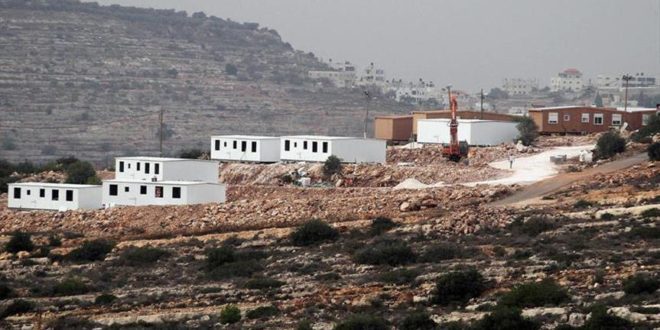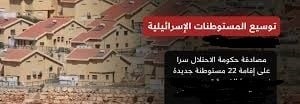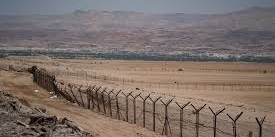By: Madeeha Al-A’raj
The National Bureau for defending land and resisting settlements ( nbprs ) stated in its latest weekly report , that Israeli Occupation Govt. continues its settlement activities in Jerusalem and other governorates of the West Bank. Major settlement projects in Jerusalem intend to transfer the presence of settlers to the center of the city, and to consolidate control over large areas of land through the deployment of settlement outposts, military camps and road networks that cut off the geographical contiguity between the Palestinian territories. Exploiting the fact that most of Jerusalemites live in “B” areas, which represent less than 9% of the governorate’s lands, while most areas of Jerusalem are “C” areas, knowing that Jerusalem represents a connection point between the most important bypass roads that connects the entire West Bank.
As for the new settlement activities of the occupation in Jerusalem, the occupation municipality announced the approval of 3 settlement plans in Al-Tur, Wadi Al-Joz and Umm Tuba, as it approved what it called “a deposit for developing a work area in the Al-Tur Neighborhood. The plan is located in the neighborhood on the edge of the city’s borders with a direct connection to the Jerusalem Road – Dead Sea, near the Olive Junction on privately owned land. The plan includes about 100,000 m2 of commercial, employment and industrial areas, with trade accompanying the main hubs, and uses that may create environmental problems will be removed from the residential areas adjacent to the plan. It also agreed to what It was called a commercial and operational complex in Umm Tuba.
The plan borders the neighborhood of Sur Baher and Umm Tuba, located east of Har Homa neighborhood and Kibbutz Ramat Rachel, north of road 398, east of Hebron road, and road No. 60. The plan is located on an area of approximately 66 dunums, and includes 11 plots of land to work with a construction size of about 75,000m2, all for different uses of labor, light industry, handicrafts and trade.
According to the “Peace Now Movement,” the current Israeli government is taking major, rapid and rolling steps in the first 4 and a half months of its life to strengthen the settlements and deepen the Israeli occupation of the Palestinian territories. Among these steps is the promotion of a set of building plans in the settlements, including plans to build 3,000 units, which were approved by the Higher Planning Council in the Civil Administration.
Among the plans are hundreds of units in isolated settlements far from the so-called settlement blocs, including 628 units in Eli, 399 units in Revava, 286 units in Har Bracha, and 380 units in Kedumim, as well as tenders for 1,355 units in a number of other settlements. On October 24, 2021, tenders for construction in settlements were revealed, including the dramatic expansion of the Ariel settlement by 731 units.
The government is promoting a plan that is considered fatal in terms of the prospects for peace and the two-state solution with 9,000 housing units in the heart of Palestinian urban contiguity between Ramallah – Kafr Aqab Qalandia and Al-Ram at Qalandia Airport, in addition to a settlement in “E1” and despite the fact that the plan was deposited by the previous government led by Netanyahu, but the discussion of the objections -which is necessary to move the plan forward – was determined by the current government and took place on October 18. Another discussion is scheduled to take place on Nov. 21, and the tender for the construction of Givat Hamatos was published and awarded before the formation of the new government.
It is known that on Oct. 24, a tender was issued for the construction of 83 settlement units in Givat Hamatos, which was not awarded in the original bid. As for the second step, it is related to the construction in the settlements, where construction work is currently underway in 31 new units in the center of Hebron city, and work has begun on the Qalandia Tunnel, a road that could significantly change the development of settlements in the West Bank.
The “Karni Re’im” farm – After an attempt to establish a farm in the Khirbet Shehadeh area ‘in the lands of Deir Istia’, in August 2021, a new agricultural farm was established near the “Havat Yair outpost” settlement in the Deir Istia’s land, where a house is inhabited. The Ramat Migron outpost: At the beginning of the year, a small farm was established on the hill on which the Migron outpost was located. It should be noted that the Israeli Ministry of Agriculture has acknowledged that it funds organizations that assist agricultural outposts in the Palestinian territories.
In Nablus, the Israeli occupation forces issued a decision to seize 10 dunums of lands from the Beit Dajan and Beit Furik towns, east of Nablus. The decision issued by the commander of the occupation forces in the West Bank justified the seizure of these lands for security purposes. Mayor of the Beit Dajan village council, Murad Abu Hanish, said that these lands are located adjacent to an old and abandoned camp for the occupation, east of Beit Dajan and Beit Furik. The confiscation of these lands will limit the farmers’ ability to access their agricultural lands.
On the other hand, a report issued by the United Nations Office for the Coordination of Humanitarian Affairs (OCHA) revealed that the rate of demolition and confiscation of Palestinian homes in their land occupied since 1967 increased by 21% in the first 9 months of this year, compared to the same period in 2020. The report said that Israel demolished, confiscated or forced the residents to demolish their homes, last Sept. by eight Palestinian-owned facilities in the West Bank, including East Jerusalem, which resulted in damage to the livelihoods of about 50 people.
The UN report estimated the number of Palestinian facilities that were confiscated. The Israeli occupation authorities, since the beginning of this year until now, have about 311 facilities, either without warning, or by giving the owners a short-term deadline, using many military orders that prevent people from being able to object in advance to the decision. Their demolition or confiscation has increased by about 96% so far in 2021 compared to the same period in 2020 “from 94 to 184”. As for the demolitions, since June 21 so far, 260 buildings have been demolished in Area C, which is almost the number that was demolished in all of 2017.
List of Israeli Assaults over the Last Week Documented by the National Bureau:
Jerusalem:
- Opening of a Judaization square on Al-Wad Street, in the Old City of the occupied Jerusalem, in addition to changing the name of the Al-Wad and Al-Alam intersection in the Old City to (Hajvora Square), which means “Heroes squre”, by changing and adding the names of the Israeli settlers who were killed in the place in 2015. It should be noted that this Judaization is the first of its kind, in terms of giving a Hebrew name to a road in the Islamic Quarter.
- The Philinenc Company notified 7 Jerusalemite families to evacuate their homes in the western neighborhood of the Sheikh Jarrah, claiming their ownership of the real estate, and that the aforementioned families broke into and used them without paying rent and various payments as well as not having licenses and permits on them.
- Demolishing 6 commercial shops belonging to Abdel Aziz Al-Khatib, near the military checkpoint in the Hazma town, and attacking all the members of the family as well as smashing the doors of the 6 shops, without allowing the shop’s tenants to reach their shops or take out their contents.
- Carrying out several provocative Judaization tours in the lands of Wadi Al-Rababa neighborhood, west of Silwan town, south of Al-Aqsa Mosque in response of seizing hundreds of dunams of the neighborhood’s lands, in favor of Israeli settlement projects.
Hebron:
- Storming the Old City of Hebron after the Israeli authorities closed the Ibrahimi Mosque and prevented Muslims from performing prayers, under the pretext of the Jewish “Sarah Sabat”.
- Attacking the citizens in the Jaber neighborhood, and spraying pepper gas over a boy which causes him burns as well as insulting the Jaber family.
- Demolishing a house in the Al-Jawaya community, east of Yatta, south of Hebron.
- Closing a water spring in the Al-Thaqara area, east of the Beit Umar town to prevent the citizens from irrigating their crops.
Bethlehem:
- Seizing a water tank in the town of Al-Khader, south of Bethlehem, under the pretext of not having a building permit.
- Attacking the olive pickers in the town of Tekoa, east of Bethlehem, including the acting ambassador from the South African Representative Office to the State of Palestine, Lesiba Machaba, in addition to firing stun grenades and tear gas, and forcing the citizens and the ambassador to leave the land.
Nablus:
- Demolishing a mosque with an area of 60 m2 in the town of Doma, south of Nablus, located in the “Shaqara” Bedouin community, east of Duma, noting that the mosque was built 2 years ago as well as notifying to demolish a 3-storey inhabited house.
- Storming the Joseph’s Tomb in Nablus to perform Talmudic prayers.
- Attacking the Palestinian vehicles on the road between Jenin and Nablus with stones as they closed the road from the junction of Silat Al-Dhahr town to the entrance to the town of Burqa, north of Nablus.
Salfeet:
- Notifying to demolish 5 houses and stopping construction in an agricultural room in the town of Kafr Ad-Dik, west of Salfit.
- Notifying to demolish the house of Sharif Fathi Sharif, located in the Makhroma area, east of the town, and to stop building an agricultural room belonging to Otbah Abdel Razek Ali Ahmed.
Qalqilya:
- Storming the lands of the citizens of Kafr Qaddoum village, east of Qalqilya, and setting up a tent and cutting olive trees, in addition to stealing the olives.
Jenin:
- Notifying to demolish a house in the Mariha neighborhood in the Ya’bad town, southwest of Jenin, under the pretext of not having a building permit.
- Detaining 6 farmers from the village of Jalboun, east of Jenin, from the Abu Al-Rub family while picking olives on their lands behind the apartheid wall, despite the fact that they have permits.
Jordan valley:
- Issuing an order to extend a water-line between the settlements of “Rotem” and “Bekaot” in the northern Jordan Valley, in preparation for the seizure of more lands of citizens in the areas of Al-Farisiyah, Ein Al-Hilweh, Wadi Al-Faw, and Samra, and to the west of Makhol, Al-Hadidiya, and Al-Baqi`ah Plain, with a length of about 12 km.
- Assaulting the child Hussein Yousef Bisharat, 14, while chasing the sheep shepherds in the Khallet Makhoul in the northern Jordan Valley.
- Notifying to remove a tent in the Khirbet Ibziq, north of Tubas, used as a health clinic.
- Imposing a siege on the Khirbat Al-Mitah, which is threatened with demolition, and expelling the families out into the open in the nearby mountainous area. Besides, demolishing the facilities designated for housing and raising livestock. The demolition operations affected 3 residential tents of 60 meters each, two sheep tents of 80 meters each, an open sheep barn of 200 meters, and a 50 meter fodder storage tent, in addition to the destruction of 3 water tanks and a solar cell system and its batteries, destroyed 30 steel bars under the pretext of not having a building permit.
 المكتب الوطني للدفاع عن الارض ومقاومة الاستيطان منظمة التحرير الفلسطينية
المكتب الوطني للدفاع عن الارض ومقاومة الاستيطان منظمة التحرير الفلسطينية




